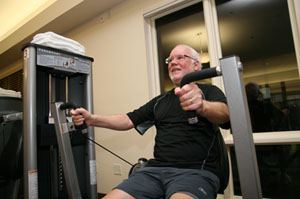Once a year, employees of the Swiss Village Retirement Community in Berne, Ind., have a checkup that will help determine how much they pay for health coverage. Those who don’t smoke, aren’t obese and whose blood pressure and cholesterol fall below specific levels get to shave as much as $2,000 off their annual health insurance deductible.
At Chicago-based Jones Lang LaSalle, a real estate firm, workers can earn up to $300 in cash for having a physical and hitting certain medical goals, or completing health coaching programs.
Gone are the days of just signing up for health insurance and hoping you don’t have to use it. Now, more employees are being asked to roll up their sleeves for medical tests — and to exercise, participate in disease management programs and quit smoking to qualify for hundreds, even thousands of dollars’ worth of premium or deductible discounts.
Proponents say such plans offer people a financial incentive to make healthier choices and manage chronic conditions such as obesity, high blood pressure and diabetes, which are driving up healthcare costs in the USA. Even so, studies of the effect of such policies on lifestyle changes are inconclusive. And advocates for people with chronic health conditions, such as heart disease and diabetes, fear that tying premium costs directly to test results could lead to discrimination.
Employee reaction has also been mixed. “It’s an invasion of privacy,” says Bradley Seff, 54, a court reporter who filed a lawsuit against his employer, Broward County, in August, 2010, for introducing such a plan.
Nonetheless, such plans could be the wave of the future. Faced with crippling healthcare costs, the number of employers embracing such programs shot up from 49 percent in 2010 to 54 percent last year — and more say they expect to do so soon, according to a survey by consultants Aon Hewitt. Big-name participants include insurer UnitedHealthcare, car rental firm Hertz, postage meter maker Pitney Bowes and media owner Gannett, owner of USA TODAY.
And more employers are expected to adopt them starting in 2014, when the health law allows them to offer larger incentives or penalties than they can now.
“We’re seeing a big move in this direction driven by employers’ concern about rising health costs and their sense that employee behavior has a lot to do with high costs,” says Kevin Volpp, a professor at the University of Pennsylvania School of Medicine, who has studied the use of incentives in health insurance programs.
Cost Savings Seen
Leaders at Swiss Village credit their eight-year-old wellness program, along with a high-deductible insurance plan and an on-site fitness center, with slowing health care cost increases. Workers saw no increase in their health premiums from 2005 to 2011.
“We continue to embrace what we’re doing,” says Daryl Martin, executive director of the nonprofit organization. Still, a few high-cost medical issues among its 230 covered employees and their dependents last year caused it to raise employee costs 14 percent this year.
What’s important, Martin says, is that the company’s approach keeps health “at the forefront of what people are thinking about.”
Of the employers who offer such programs, about one-third offer financial incentives to those who undergo specific medical tests, according to the Aon Hewitt survey. And 5 percent of those tie the financial rewards or penalties to meeting specific medical-based standards.
The survey also found the use of medical screening tests poised to expand to family members: 57 percent of employers said they planned to add incentives for spouses and dependents in the next three to five years.
“A lot of costs come from spouses, but only 29 percent had incentives for spouses,” says Cathy Tripp, a senior vice president at Aon.
Starting in 2014, federal law allows employers to raise the value of the perk or penalty from 20 percent of the cost of a worker’s health insurance plan, to 30 percent. Based on the average cost of employer-offered insurance today, that means firms will be able to offer annual discounts or penalties of more than $4,500 a family, or $1,600 for individuals.
Employers will still have to craft plans to comply with federal and, in some cases, state requirements, Volpp says. The programs must be voluntary — meaning an employer can’t require a worker to participate as a condition of coverage. And the employer must offer a “reasonable alternative” to qualify for the reward, or to avoid the penalty for those who can’t achieve the sought-after medical goals.
But Dick Woodruff, vice president of federal relations for the American Cancer Society Cancer Action Network, worries there’s no definition of what a reasonable alternative must include.
Some workers complain the programs are an intrusion into their private lives.
“They portrayed it as voluntary, which it isn’t, because if you don’t participate, they fine you every paycheck,” says Seff, the former Broward employee who is suing over the program. He has since retired on disability with back and neck problems. “I don’t think any employer should do it.”
In an effort to slow rising health care costs, Broward County in 2009 began asking workers to fill out a health information form and have a finger-stick blood test each year to check blood sugar and cholesterol levels, according to court filings. Workers who declined were docked $40 a month.
Those who did participate were offered disease management programs if they had asthma, high blood pressure, diabetes, congestive heart failure or kidney disease. The county stopped docking those who declined to participate Jan. 1, 2011, after Seff’s suit was filed, court documents say.
The lawsuit, which argues the county’s program violates the Americans with Disabilities Act, is likely the first of its kind in the nation, says Seff’s attorney Daniel Levine in Boca Raton, Fla. Without ruling on whether the wellness effort was voluntary, a federal district court judge backed the county in April, 2011, saying the plan fell under provisions of the law meant to protect bona fide benefit programs. The case is now on appeal. Broward County attorneys did not return requests for comment.
Some state lawmakers are also concerned about the potential for discrimination. Colorado passed legislation in 2010 that requires wellness programs to be accredited, bars penalizing workers for not participating, or failing to meet a health standard — and allows appeals if an employee is denied an alternative. A similar bill was brought unsuccessfully in California last year, according to a February report by Georgetown University’s Health Policy Institute.
While supporting wellness programs in general, several patient advocacy groups warned the Obama administration last March that additional consumer protections are needed. Tying medical test results to financial incentives or penalties in premiums or deductibles could discriminate against some workers, especially those who already have health problems, the groups said.
“When you start increasing premiums or pumping up the deductibles, you’re making it more expensive and harder for people to access insurance,” says the Cancer Society’s Woodruff, who adds that offering gift cards or bonuses are a better way to reward people for participation.
Employers, however, argue that since they’re on the hook for the bills, they can ask workers to take more responsibility.
“House money, house rules,” says Ken Sperling, global healthcare practice leader at Aon Hewitt.
Humble Beginnings
The first worker wellness programs, which began about a decade ago, rewarded simple participation: attending a health fair or filling out a “health risk assessments,” with the worker perhaps receiving a $25 gift card in return.
Today, many offer discounted premiums to workers who meet standards related to blood pressure, cholesterol and weight, with the value of those discounts running between $30 and $60 a month, says Jim Pshock, founder and CEO of Bravo Wellness in Avon, Ohio. Pshock administers such wellness programs for about 220 employers nationwide, including Colorado construction firm Oakwood Homes and Nashville’s Ardent Health Services.
Although employers may set specific goals — such as a body mass index (BMI) below the 30, the level considered obese — many also reward achievement of less daunting targets. One employer rewarded workers if their test results didn’t get any worse, Pshock says.
At Swiss Village, workers get $500 off their deductible for each of these measures: not smoking, having a BMI of 27.5 or less, a low-density lipoprotein cholesterol level (LDL) of 130 milligrams per deciliter or less, and blood pressure of 130/85 or less. LDL levels above 129 are associated with higher risk of heart disease, while blood pressure greater than 120/80 is considered a risk factor for heart attack and stroke.
A second tier of awards allow workers who approach those ranges to earn $250 per category. The testing takes place at an on-site health fair, or at a doctor’s office with the results gathered by an independent insurance firm that runs the program for the company.
Federal laws allow employers to require workers to fill out a health risk assessment, but bar them from learning a specific worker’s answers, although they can get results in aggregate. The Genetic Information Nondiscrimination Act of 2008 also limits employers’ ability to ask about family history or require genetic testing.
The information is generally gathered by firms that run wellness programs or insurance plans. UnitedHealthcare, which offers its “Personal Rewards” program to large, self-insured clients, says it does not use the information to set premiums.
Pshock says some of his clients share the information with their insurers, who may “recognize the significance of a program … with a 3 percent to 6 percent rate reduction.” Many insurers, however, take “more of a wait-and-see-if-the-health-improvement-results-in-fewer-claims approach,” he says.
But Do They Work?
Given the available data, it’s hard to parse how much of the reported savings from such programs come from improved health, and how much from the frequent pairing of such programs with high deductible policies, which shift more costs onto workers.
“We just don’t know how effective (incentives) are,” says Volpp. There is pretty good evidence they help smokers quit, he says, but less that they prompt workers to lose weight and keep it off.
Weight gain is partly a function of genes and environment, he says, so programs that tie incentives to achieving a particular weight range are “in essence, penalizing people for factors they can’t control or can only partly control” – either because they’ve failed to lose weight or haven’t participated in the program.
Volpp says the medical literature shows that incentives work best when participants have choices: get below a certain BMI, or lose 5 percent of current body weight, for example. And, he says, rewards should be immediate.
“If you want the employee to do a health assessment or (medical) screening, you should give them the reward right after they do it” he says.
At Jones Lang LaSalle, workers who make a pledge — on the honor system — that they don’t smoke, or will take a stop-smoking class, and achieve a healthy weight, get 10 percent off their contribution toward insurance premiums.
In 2010, the firm added a cash bonus program, offering $50 to workers who get a physical and another $50 for every one of four medical tests they take: weight, blood pressure, glucose and cholesterol, plus an extra $50 if they do all the tests. If they meet specified goals — or complete a coaching program — they get the money in the form of a cash bonus. Spouses and domestic partners are also eligible, says Howard Futterman, senior vice president of benefits.
Last year, 65 percent of employees participated. While it’s early, he says, indications are the program is having an impact on costs: health spending rose 6 percent in 2010, but only 3 percent in 2011.
“Our long term goal is to make health and well-being part of our culture and everyday values,” says Futterman. “When people start doing it naturally and you don’t have to pay them for it, that’s when you know you’ve succeeded.”









